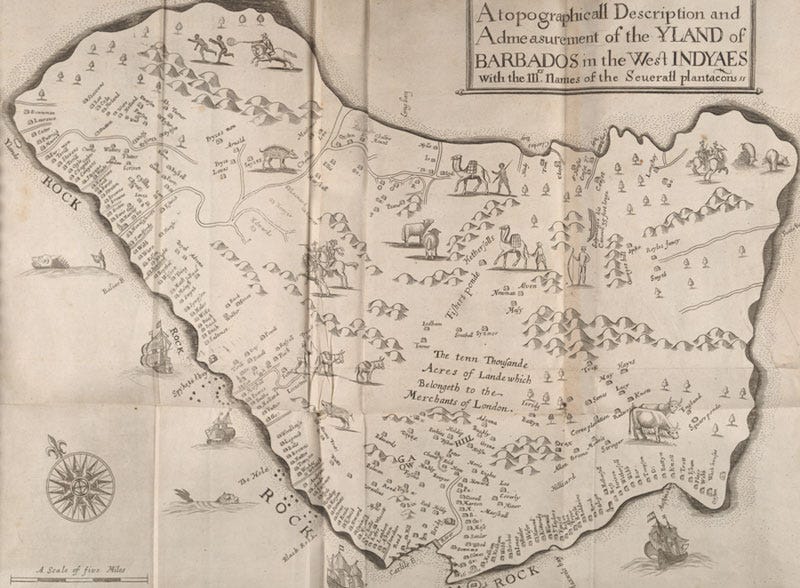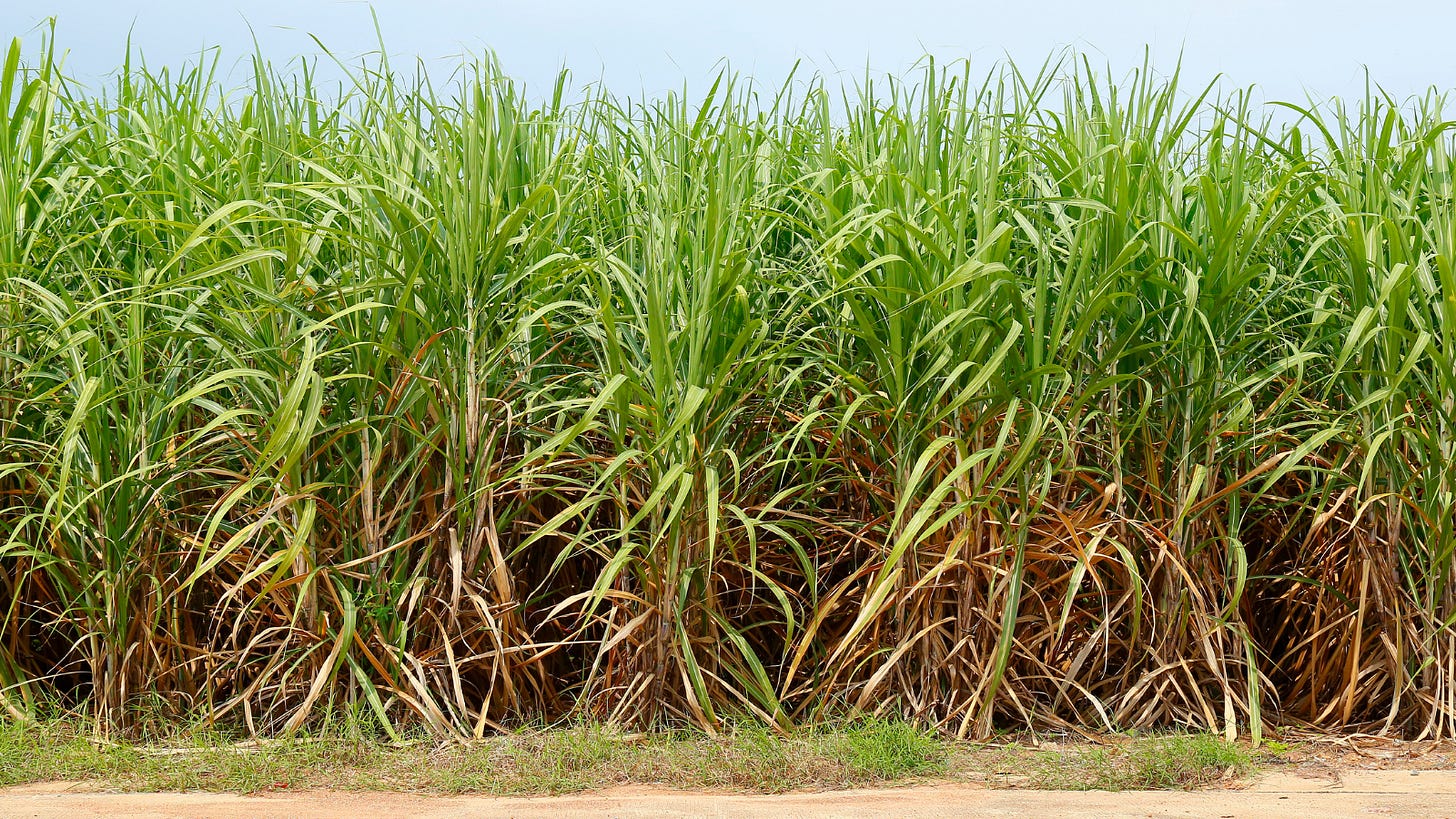Discovering sugarcane: A sweet plant's history and uses
How sweet it is! This grass grows to a height of 10-13 feet high and supplies most of the world’s sugar market.
Good morning and greetings from sunny Barbados! Barbados is a small island nation in the eastern Caribbean, known for its beautiful beaches, vibrant culture, and tropical climate. It is situated southeast of Saint Lucia, characterized by its coral reefs, rolling hills, and historical landmarks. Barbados was a British colony from 1625 until gaining independence in 1966. It has a parliamentary system of government with a prime minister as the head of government, and until recently, the country was a member of the Commonwealth of Nations. In 2021, Barbados formally cut ties with Britain, removing Queen Elizabeth II as its head of state and electing the nation’s first President.
I’m here for a special conference to meet with scientists from across the region on biodiversity and medicinal plants called Plants and Planting for the Future 2023, organized by the Biocultural Education and Research Program. Recordings of the symposium lectures will be posted at this website at a later date.
When thinking about which plants found in Barbados to highlight this week in the newsletter, two immediately came to mind due to their economic and dietary importance: sugarcane and breadfruit. Interestingly, neither are from the Caribbean but were brought here in colonial times. Today, I’ll dive into the history and pharmacology of sugarcane. Thursday, we’ll cover breadfruit.
About sugarcane
Sugarcane is both a friend and a foe when it comes to human health. It is a sweet-tasting grass that can be transformed into several delicious treats, whether in its crystalline, juice, syrup, or even alcoholic form. You likely use this plant daily, though, for those with a health-conscious diet, you may work to limit its consumption. This plant is currently responsible for nearly 80% of the global production of sugar and is the world’s largest crop by production quantity! In 2019 alone, 1.9 billion tons of this crop were produced, with Brazil accounting for 40% of the world's total. Barbados produced around 7,000 tons of sugarcane in 2019. It is estimated that about 64 million acres of sugarcane are planted across the tropics each year.
Origins
The dominant sugarcane species used today originated in New Guinea, where it was domesticated around six thousand years ago. Sugarcane has many uses and applications, starting with the simple use of raw sugarcane, which is chewed to extract the juice. The extracted juice is also used in several beverages, often combined with lemon juice. Cane sugar syrup was once used heavily as a sweetener in commercial beverages, but this has been supplanted using the much cheaper corn syrup. Molasses is used in different recipes, including the production of rum. Rock candy is also a popular treat, made from crystallized cane juice.
The scientific name of sugarcane is Saccharum officinarum, and it is a member of the Poaceae, or grass, family. Sugarcane is a tropical, perennial grass that sends out lateral shoots at the base of the plant to support multiple stems. As these stems grow, they become stalks that reach 10-13 feet tall, fibrous, and made up of anywhere from 63-73% water. They are also rich in sugars, representing 12-16% of the stalk.
As sugarcane made its way from New Guinea westward, it underwent additional periods of domestication. By the tenth Century, sugarcane was grown in many villages across historic Mesopotamia, which covers the regions of modern-day Iraq, Kuwait, and northern Saudi Arabia.
Sugarcane and the Triangular Trade

Sugarcane was also one of the early crops brought to the Americas and made up a central piece of the trade triangle in New World raw materials. Tragically, the desire for this crop and the economic boom it brought fostered the slave trade of Africans, orchestrated by European colonists in the Americas. The conditions of this time were horrific and inhumane on every level, regardless of location of tropical plantations. In addition to suffering from malnutrition and violence at the hands of the slave transporters and owners—planting, harvesting, and processing sugarcane was exceptionally dangerous. The blades used to cut the cane also cut into legs when harvesters had a short moment’s lapse in attention. The gears used to squeeze out the juice could quickly grab a finger and then drag the whole body in and crush it. The boiling houses (where the juice was processed in steaming kettles, the foam skimmed, and the molasses and sugar crystals formed) was also a danger when hit by the blistering hot bubbles of the brew as it cooked.
In 1833, when the British Empire liberated enslaved people and many left the sugar fields, the plantation owners looked for other cheap forms of labor. They found it through the model of indentured service from China, Portugal, and India under similarly dangerous conditions for the laborers. Much wealth was produced for Europeans involved in directly running or investing in the production and sale of sugarcane and its byproducts.
Processing sugarcane
Today, plentiful sunshine and water requirements restrict sugarcane cultivation to tropical and subtropical regions. In the US, sugarcane cultivation is limited to Florida, Louisiana, and South Texas, where mechanization of agriculture has reduced the dangers in growing and processing the plants.
Although sugarcane does produce seeds, planting stem cuttings has become the norm in efforts towards conformity of the crop. Depending on where the crop is cultivated, the harvesting methods differ. In the tropics, hand harvesting is still a dominant method, accounting for about half of all production. In this technique, the field is first burned to remove dead leaves and underbrush and to chase away rats and snakes. Then the cane stalks are harvested by hand using cane knives or machetes. In the US, however, the cane is harvested with a mechanized harvester.
Once harvested, sugarcane can rapidly lose its sugar content, so it needs to be sent to the sugarcane mill soon after being cut. There, the canes are shred, the juice extracted and clarified by removing solids from the liquid, and then evaporated to form a thick syrup. This syrup is also clarified to remove any solids like mud, waxes, or fibers, and then it goes through the process of crystallization to create sugar crystals. A centrifuge (a machine that spins down the liquid) separates the remaining syrup from the crystals, which are subsequently dried. The remaining fibers are known as the bagasse, and this waste product is commonly burned as fuel to support the steam boilers of the sugar mill. In Brazil, sugarcane juice is used in aguardiente production and results from the distillation of fermented sugarcane juice, yielding an ethanol content between 38% and 54% by volume.
Other byproducts of this process include molasses and filter cake. Filter cake results from industrial sugarcane processing and is obtained from the rotation filters after residual sucrose is extracted from the sugar production leftovers. It is used as a livestock feed supplement and fertilizer, whereas molasses is used as food, a food supplement, or as the starting material for making ethanol or rum.
How sugarcane came to Barbados

Sugarcane was first introduced to Barbados in the 1620s when the English colonized the island, but techniques for growing and processing sugar as a commercial enterprise didn’t really take off until the 1640s with the arrival of Dutch settlers from Brazil. The cultivation of sugarcane became the main economic activity and led to the establishment of large sugar plantations and the importation of enslaved Africans to work on them. Today, sugarcane is still grown in Barbados, although it is no longer the dominant industry—replaced by tourism and international business.
Making rum

I’m fascinated by the fermentation and distillation of plant ingredients into value added products like spirits, and Caribbean rum is no exception! If you’d like to learn more about the process of making rum, check out this episode of Foodie Pharmacology in which I interview Joy Spence, the Master Blender of Appleton Estates in Jamaica, about her specially crafted rums. Listen here or you can watch the full episode on the Teach Ethnobotany YouTube Channel.
Medicinal history
Sugarcane has a long history of use as a food for humans and animal feed. In traditional medicine in India, sugarcane juice is widely used in the treatment of jaundice, hemorrhage, and urinary diseases. However, excessive consumption of sucrose (the molecule consumed as a sweetener and energy source derived from sugarcane) may cause gastrointestinal problems and lead to dental caries (cavities!). High consumption of sucrose has also been linked to a number of health problems, such as cardiovascular diseases, type II diabetes, obesity, and hypertension.
On the other hand, studies have shown that sugarcane has some health-promoting effects. For example, aliphatic primary acids purified from sugarcane wax have shown promising cholesterol-lowering effects in both animal and humans. Additionally, the phenolic compounds found in sugarcane bagasse have demonstrated antimicrobial activities against several foodborne pathogens, and studies have linked the leaves and juice of sugarcane to DNA damage-protecting effects as well as antioxidant activity, which is attributed to the phenolic content of the plant.
Wrap-up
Sugarcane has come a long way since its domestication, spread across the tropics, and refinement into a wide array of products that we enjoy today. Whether you prefer to savor sugarcane by chewing it fresh from the stalk, indulging in dark molasses on hot rolls, savoring sugary confections, or sipping tropical rum punches, it's fascinating to reflect on the remarkable journey of this versatile plant.
Yours in health, Dr. Quave
Cassandra L. Quave, Ph.D. is a scientist, author, speaker, podcast host, wife, mother, explorer, and professor at Emory University School of Medicine. She teaches college courses and leads a group of research scientists studying medicinal plants to find new life-saving drugs from nature. She hosts the Foodie Pharmacology podcast and writes the Nature’s Pharmacy newsletter to share the science behind natural medicines. To support her effort, consider a paid or founding subscription, with founding members receiving an autographed 1st edition hardcover copy of her book, The Plant Hunter.









Type 2 diabetes do you have any recommendation to get it under control?
Two food plants that immediately come to mind are okra and bitter melon. I’ll add these species to my list for future topics to cover.